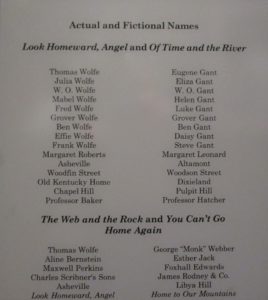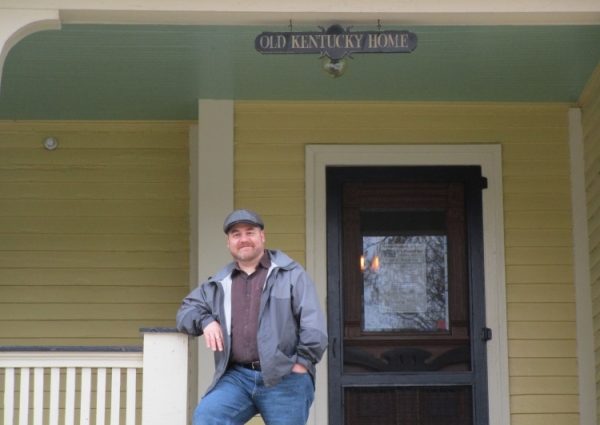At the end of February, we packed our bags (masks, sanitizer, and alcohol spray included) and took a daytrip to downtown Asheville, North Carolina, to visit the Thomas Wolfe Memorial, honoring the Appalachian writer, novelist, playwright, and poet, Thomas Wolfe. We took the scenic route on 25-W and it was a gorgeous drive through the peaked Appalachian Mountains, beside the raging French Broad River. After about 2 ½ hours, we reached our destination. The memorial pays great tribute to Wolfe and provides various bits of items and ephemera from the entire family. The museum arranges a linear timeline that captures sections of Wolfe’s life. For example, one section spans years 1901-1906, another from 1906-1916, and so on. At the beginning of each era, a small biographical write-up along with images are interspersed with excerpts (mostly) from his famous novel, Look Homeward, Angel. Each exhibit houses period furniture with the Wolfe family’s belongings added here and there.
The Thomas Wolfe Museum
Adjacent to the museum/gift shop is Thomas’s mother Julia Wolfe’s boardinghouse, the Old Kentucky Home, where he spent much of his childhood. We took the guided tour and saw what life was like as an early 20th century boarder. Every room uses period furniture, with an early (modernized) conception of electricity and plumbing. The Queen Anne Victorian style house was originally built with 18 rooms in 1883 by banker Erwin Sluder as a wedding gift for his daughter. In 1889, it became a boardinghouse under the ownership of Mrs. Alice Reynolds, who made it complete with electricity and indoor water. Julia Wolfe bought the house in 19061)Thomas Wolfe Memorial. “The House 1880s-1950s.” Thomas Wolfe Memorial. nd. (accessed Feb 2021). “hoping to cash in on Asheville’s tourist trade.”2)Holman, C. Hugh. Thomas Wolfe. Minneapolis: University of Minnesota Press, 1960. p. 15 In 1916, she would add around eleven more rooms. The Thomas Wolfe Memorial began in 1949 and is currently managed by the North Carolina State Historical Site. The house was made an official National Historic Landmark in November 1971 (To find the house on the latter link, scroll down to “North Carolina” and it’s under “Wolfe, Thomas, House.”).
The Old Kentucky Home Exterior
While Thomas did spend about six years at 92 Woodfin Street, a house his father built for a previous wife,3)Mitchell, Ted. 1999. Thomas Wolfe: A Writer’s Life. Raleigh: Appalachian Consortium Press. p. 8 he lived at the Old Kentucky Home for the rest of his childhood. He records it as being a miserable experience, never having a room or place, being “shifted from one room to another.”4)Donald, David Herbert. 1987. Look Homeward: A Life of Thomas Wolfe . New York: Fawcett Columbine – Ballentine Books. p. 12 He ate meals in small spaces and rarely had privacy. Everything revolved around the boarders – make room for the boarders (as cheaply as possible), make money from the boarders (as much as possible). Wolfe explains his feelings about being there:
My overloaded heart was bursting with its packed weight of loneliness and terror; I was strangling, without speech, without articulation, in my own secretions – groping like a blind sea-thing with no eyes and a thousand feelers toward light, toward life, toward beauty and order, out of that hell of chaos, greed, and cheap ugliness.5)Donald, David Herbert. 1987. Look Homeward: A Life of Thomas Wolfe . New York: Fawcett Columbine – Ballentine Books. p. 14
The Old Kentucky Home Interior
Thomas Clayton Wolfe was born on October 3, 1900 in Asheville, North Carolina, to William “W.O.” Oliver Wolfe and Julia Elizabeth Westall Wolfe. He was named Thomas after his maternal grandfather, and Clayton from “spiritualist clergyman, William Clayton Bowman.”6)Mitchell, Ted. 1999. Thomas Wolfe: A Writer’s Life. Raleigh: Appalachian Consortium Press. p. 2 His father was a stonecutter from Adams County,7)Mitchell, Ted. 1999. Thomas Wolfe: A Writer’s Life. Raleigh: Appalachian Consortium Press. p. 3 Pennsylvania, having apprenticed for the trade after the early death of his father. He changed his surname from Wolf to Wolfe, adding an e to the end to appear “more elegant.”8)Mitchell, Ted. 1999. Thomas Wolfe: A Writer’s Life. Raleigh: Appalachian Consortium Press. p. 4 He worked toward a successful monument (tombstone) business. Thomas’s mother was born in Swannanoa, North Carolina (Buncombe County),9)Mitchell, Ted. 1999. Thomas Wolfe: A Writer’s Life. Raleigh: Appalachian Consortium Press. pgs. 5-6 and was brought up fairly poor after the Reconstruction years,10)Donald, David Herbert. 1987. Look Homeward: A Life of Thomas Wolfe. New York: Fawcett Columbine – Ballentine Books. p. 6 thereby having a sporadic six years of education. She “bluffed her way into jobs as a country school teacher,”11)Mitchell, Ted. 1999. Thomas Wolfe: A Writer’s Life. Raleigh: Appalachian Consortium Press. p. 7 then became a door-to-door bookseller.12)Holman, C. Hugh. 1960. Thomas Wolfe. Minneapolis: University of Minnesota Press. p. 12 A shrewd and clever businesswoman, she saved just about every dime she made to buy real estate.13)Mitchell, Ted. 1999. Thomas Wolfe: A Writer’s Life. Raleigh: Appalachian Consortium Press. p. 7 The couple had eight children, five living past infancy.14)Holman, C. Hugh. 1960. Thomas Wolfe. Minneapolis: University of Minnesota Press. p. 13 Thomas was the baby of the family.

Thomas attended public schools, then the North State Fitting School.15)Mitchell, Ted. 1999. Thomas Wolfe: A Writer’s Life. Raleigh: Appalachian Consortium Press. p. 17 He received his first literary award some time after leaving North State – the “bronze medal of the Independent Magazine’s citywide school essay contest.”16)Mitchell, Ted. 1999. Thomas Wolfe: A Writer’s Life. Raleigh: Appalachian Consortium Press. p. 19 When he was fifteen years old, he attended the University of North Carolina and was “the only one of his family to reach that educational level.”17)Holman, C. Hugh. Thomas Wolfe. Minneapolis: University of Minnesota Press, 1960. p. 13 He was quite the ladies’ man (“women of dubious virtue”)18)Mitchell, Ted. 1999. Thomas Wolfe: A Writer’s Life. Raleigh: Appalachian Consortium Press. pgs. 26-27 during his college years and beyond. The first thing Thomas had published was a poem, “A Field in Flanders,” in the University of North Carolina Magazine (November 1917).19)Mitchell, Ted. 1999. Thomas Wolfe: A Writer’s Life. Raleigh: Appalachian Consortium Press. p. 28 He graduated at twenty years old, then attended Harvard and earned a Master of Arts degree in English literature.20)Holman, C. Hugh. Thomas Wolfe. Minneapolis: University of Minnesota Press, 1960. p. 14 He wanted more than anything to be a playwright. At Harvard, he enrolled in several playwriting courses. His first performed play was The Mountains – “a folk play about North Carolina.” The production failed because most audiences found it too dark and depressing. After completing his first manuscript, he shopped it at various publishers, but no one took the bait. The name of the manuscript was Look Homeward, Angel. He worked six years as a professor teaching “three classes in freshman English and an introductory course in literature for schoolteachers.”21)North Carolina Historical Society. nd. “A Brief Biography of Thomas Wolfe.” WayBack Machine – Internet Archive.
Eventually, Charles Scribner’s Sons finally published his manuscript. Look Homeward, Angel is arguably Wolfe’s most popular novel. The book tells the story of Eugene Gant, a young man born in Western North Carolina, whose father was a stonecutter and whose mother ran a boardinghouse. (Sound familiar?) The book’s “lyric intensity and its dramatic power were immediately recognized and hailed . . . Wolfe was recognized as a figure to be reckoned with in the literary world.”22)Holman, C. Hugh. Thomas Wolfe. Minneapolis: University of Minnesota Press, 1960. p. 16 Wolfe was excited to receive such well-deserved praise, but felt an ever-mounting pressure to create yet another masterpiece. Though the book enjoyed worldwide popularity, Ashevillians were livid over the writing because, while the characters may have slightly different names, enough hints told the reader who they were. He aired dirty laundry – a no-no in the South and Appalachia. After several years, however, all was forgiven and Wolfe was warmly welcomed back home. A great aspect in Thomas’ writings is “his effective use of language in his accurate and vivid dialogue.” He had “a remarkable ear for folk speech, and his people speak personal dialects set down with great verisimilitude.” The characters speech “is always marked by distinctiveness in diction, syntax, and cadence.”23)Holman, C. Hugh. Thomas Wolfe. Minneapolis: University of Minnesota Press, 1960. p. 30
Thomas Clayton Wolfe died of tuberculosis that spread to his brain at 5:30 a.m. on September 15, 1938. He was only 37 years old. On a future post, Appalachia Bare will go into greater detail on this talented Appalachian writer’s short yet full and passionate life.
*ALL PHOTOGRAPHS TAKEN BY TOM AND DELONDA ANDERSON
**Featured Image: Thomas Anderson outside the Old Kentucky Home
***Title quote from Thomas Wolfe
References
| ↑1 | Thomas Wolfe Memorial. “The House 1880s-1950s.” Thomas Wolfe Memorial. nd. (accessed Feb 2021). |
|---|---|
| ↑2 | Holman, C. Hugh. Thomas Wolfe. Minneapolis: University of Minnesota Press, 1960. p. 15 |
| ↑3 | Mitchell, Ted. 1999. Thomas Wolfe: A Writer’s Life. Raleigh: Appalachian Consortium Press. p. 8 |
| ↑4 | Donald, David Herbert. 1987. Look Homeward: A Life of Thomas Wolfe . New York: Fawcett Columbine – Ballentine Books. p. 12 |
| ↑5 | Donald, David Herbert. 1987. Look Homeward: A Life of Thomas Wolfe . New York: Fawcett Columbine – Ballentine Books. p. 14 |
| ↑6 | Mitchell, Ted. 1999. Thomas Wolfe: A Writer’s Life. Raleigh: Appalachian Consortium Press. p. 2 |
| ↑7 | Mitchell, Ted. 1999. Thomas Wolfe: A Writer’s Life. Raleigh: Appalachian Consortium Press. p. 3 |
| ↑8 | Mitchell, Ted. 1999. Thomas Wolfe: A Writer’s Life. Raleigh: Appalachian Consortium Press. p. 4 |
| ↑9 | Mitchell, Ted. 1999. Thomas Wolfe: A Writer’s Life. Raleigh: Appalachian Consortium Press. pgs. 5-6 |
| ↑10 | Donald, David Herbert. 1987. Look Homeward: A Life of Thomas Wolfe. New York: Fawcett Columbine – Ballentine Books. p. 6 |
| ↑11, ↑13 | Mitchell, Ted. 1999. Thomas Wolfe: A Writer’s Life. Raleigh: Appalachian Consortium Press. p. 7 |
| ↑12 | Holman, C. Hugh. 1960. Thomas Wolfe. Minneapolis: University of Minnesota Press. p. 12 |
| ↑14 | Holman, C. Hugh. 1960. Thomas Wolfe. Minneapolis: University of Minnesota Press. p. 13 |
| ↑15 | Mitchell, Ted. 1999. Thomas Wolfe: A Writer’s Life. Raleigh: Appalachian Consortium Press. p. 17 |
| ↑16 | Mitchell, Ted. 1999. Thomas Wolfe: A Writer’s Life. Raleigh: Appalachian Consortium Press. p. 19 |
| ↑17 | Holman, C. Hugh. Thomas Wolfe. Minneapolis: University of Minnesota Press, 1960. p. 13 |
| ↑18 | Mitchell, Ted. 1999. Thomas Wolfe: A Writer’s Life. Raleigh: Appalachian Consortium Press. pgs. 26-27 |
| ↑19 | Mitchell, Ted. 1999. Thomas Wolfe: A Writer’s Life. Raleigh: Appalachian Consortium Press. p. 28 |
| ↑20 | Holman, C. Hugh. Thomas Wolfe. Minneapolis: University of Minnesota Press, 1960. p. 14 |
| ↑21 | North Carolina Historical Society. nd. “A Brief Biography of Thomas Wolfe.” WayBack Machine – Internet Archive. |
| ↑22 | Holman, C. Hugh. Thomas Wolfe. Minneapolis: University of Minnesota Press, 1960. p. 16 |
| ↑23 | Holman, C. Hugh. Thomas Wolfe. Minneapolis: University of Minnesota Press, 1960. p. 30 |












































Great photos! (especially the Featured Image) I really appreciate the scholarly way the writers for Appalachia Bare take the time to reference their writings.